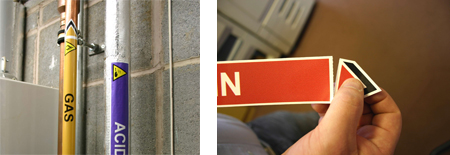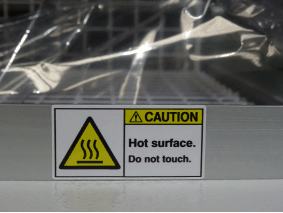There was worrying news from the HSE (Health & Safety Executive) this week: workplace fatalities are becoming more common in the United Kingdom, with 2015/16 seeing a slight increase in deaths compared to 2014/15.
According to provisional figures, there have been 144 workplace fatalities in the UK over the past 12 months - that's 2 more than the 2014/15 total of 142 (source). Not a huge difference, you may think, but it's shocking to learn that the annual number of fatal accidents has gone up at all; with safety practices now better (and regulations stricter) than ever, we really ought to be seeing a sizeable decrease in workplace deaths from one year to the next.
Chris Green, a partner at a law firm based in Liverpool, responded to the HSE's latest figures with the following statement (originally published on www.liverpoolecho.co.uk):
"One death in the workplace is too many and employers must do more to ensure the safety of their staff when on the job. Initiatives such as visible boardroom involvement and leadership of safety culture programmes have been shown to reduce accidents at a time when the costs of not doing enough to ensure safety are higher than ever before."
It is somewhat depressing to have to revisit this lesson so soon after Health & Safety Week, but this news demonstrates that the theme for H&S Week 2016 - 'Inspiring excellence in health & safety' - is one that a lot of UK businesses could stand to think about. "Employers must do more", said Mr Green, and unless we as a country want to see that annual death toll continue to rise, we all need to ask ourselves if there's more we could be doing in our own offices, warehouses, and work sites. Have you identified all potential risks that your employees face? What are you doing to address those risks and prevent the worst from happening?
For more health and safety commentary and insight, be sure to follow Label Source on Twitter or Facebook.
We sell a wide range of tags, labels and signs here at Label Source, all of which have certain applications around the workplace. But what if you want to create a notice of your own? What if you've printed out some important information on A4 paper, and now you need a way of displaying it prominently around your premises?
Actually, we can help with situations like this as well. Our clear plastic document pockets are perfect for notices and documents that need to be clearly exhibited in the workplace; the pockets come in a variety of different sizes (A3, A4, A5 and A7) and orientations (portrait/landscape), giving you an easy way to convey printed information to your colleagues.
Our best-selling document pockets come with self-adhesive backing that allows the user to simply attach the pocket (and the document therein) to the appropriate surface with zero hassle or fuss. However, if our self-adhesive document pockets aren't suitable for your needs, we offer a variety of other attachement methods, including:
To browse our document pocket range and place your order online, please click here.
One ever-popular health and safety issue on social media concerns the dangerous practices that people continue to engage in when working at height.
Incredulous bystanders, armed with their mobile phones, are able to photograph the latest misuse of ladders or steps as workers foolishly attempt to defy the laws of gravity.
Inadequately prepared, these 'cowboy builders' often improvise means of reaching areas well outside their reach. They have supreme confidence in their abilities, which - they seem to believe - include everything from the balance and the dexterity of a trained gymnast to the strength of a strongman and the analytical capabilties of a mathematician. The ladder structures often balance precariously, sometimes aided by assistants who have to support the structure with brute strength while the ladder user is fully extended from the topmost rung.
However, health and safety statistics reveal that falls from height continue to be the most common type of fatal accident, accounting for 29% of all UK workplace deaths in 2014-15. Also, it is a major contributor to loss of working days due to recovery from injuries sustained through falling. Regrettably, these figures remain stubbornly high, showing no indication of decreasing.
So, as the bystanders capture the action, they have every reason to fear the worst, as things are likely to have a sad ending - if not today, then in the future, as luck and extremely good fortune cannot go on forever.
All photos from @davidgcant on Twitter. Be sure to follow @LabelSourceUK if you're a Twitter user yourself!
If there are visible pipes on your premises and those pipes contain potentially hazardous substances, you are required by UK law to ensure that the pipes are clearly labelled to warn people of each pipe's contents. The Health and Safety (Safety Signs and Signals) Regulations 1996 state the following:
"Visible pipes in the workplace containing or transporting hazardous substances and mixtures should generally be labelled with the relevant pictograms in accordance with CLP Regulation."
If you have unlabelled pipes in your building, we recommend using our pipeline flow labels to mark your pipes and ensure that you are meeting your occupational health and safety obligations.

We sell flow labels for all kinds of different pipelines - our range covers everything from different types of water (e.g. Hot Water, Chlorinated Water) to hazardous chemicals such as Phosphoric Acid. Each self-adhesive label is printed with the name of the susbtance inside the pipe, and the range is also colour-coded to make identification even quicker. For example, the labels for water pipes are coloured green, air pipe labels are light blue, hazardous chemicals are purple, and so on.
These labels also make it easy to identify the direction of the pipe's flow. Each label has a detachable arrow on either end; when applying the label, you can simply tear off the arrow you don't need to show which way the pipe's contents are flowing. This quick visual indicator makes the nature of each pipe even clearer, and may come in handy for plumbers and/or service personnel.

Labels corresponding to hazardous substances/mixtures include hazard triangle pictograms, ensuring that your pipes meet the requirements set out in The Health and Safety (Safety Signs and Signals) Regulations 1996.
Click here to browse our full range of flow labels.

If you need to stock up on ANSI labels, we at Label Source can help - we stock an extensive variety of ANSI safety labels, which can be used to identify the following hazards (among others):
- High voltages
- Crush hazards / pinch points
- Harmful chemicals
- Hot surfaces
- Environments that necessitate the use of PPE (Personal Protective Equipment)
All of our ANSI labels are made of self-adhesive vinyl with a clear polyester laminate. The labels are available in two different sizes (25mm x 50mm and 50mm x100mm), and we supply them in packs of 100 labels each.
What is ANSI?
ANSI stands for the American National Standards Institute. This organisation is responsible for a huge number of different standards in use throughout the United States; they also work to co-ordinate American standards with international standards to ensure that products manufactured in the USA can be used in other countries.
Our ANSI Safety Labels
The labels in our ANSI range are specifically made to comply with the American National Standards Institute's guidelines for health and safety labelling. Each one looks something like this:
The top-right part of the label will usually say WARNING, DANGER or CAUTION. Underneath this is a description of the hazard in question (e.g. 'Pinch point') and/or a set of safety instructions for those who might come into contact with this hazard (e.g. 'Keep hands clear'). The left-hand side of the label is occupied by a universally-recongisable hazard warning symbol; these symbols are identical to those used in the United Kingdom and the EU in accordance with ISO EN 1710 and the Safety Signs and Signals Regulations 1996.
Click here to browse our collection of ANSI labels, or visit our Safety Labelling department to view our full range of hazard warning labels.